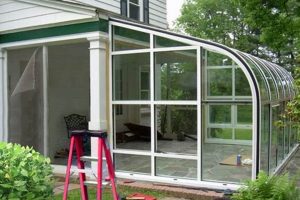A collection of components and instructions designed for individuals to assemble a functional cutting tool. These sets typically include a blade blank, handle material (such as wood, Micarta, or G10), fasteners (pins, screws, or rivets), and potentially, finishing supplies like sandpaper or oils. This allows hobbyists and craftspeople to create a personalized edged implement according to their own preferences and skill level. For example, an enthusiast might purchase a kit with a high-carbon steel blade and walnut scales to create a custom hunting knife.
The practice offers several advantages. It provides a cost-effective alternative to purchasing a pre-made, custom tool. Furthermore, the assembly process facilitates an understanding of knife construction, maintenance, and material properties. Historically, self-made implements were essential for survival and trade. The modern manifestation allows individuals to connect with this tradition and exercise creativity in a practical manner. The resulting product can have significant sentimental and functional value, reflecting the time and effort invested in its creation.
The following sections will delve into specific considerations such as blade steel selection, handle design principles, and the tools and techniques required for successful construction. These topics will equip the reader with the knowledge necessary to embark on this engaging and rewarding project.
Essential Assembly Guidelines
The following guidelines offer crucial considerations for successfully creating a custom edged tool from a collection of parts. Diligence and adherence to safety protocols are paramount throughout the construction process.
Tip 1: Blade Steel Selection. The choice of steel significantly influences the finished tool’s performance. High-carbon steels offer excellent edge retention but are susceptible to corrosion. Stainless steels are more corrosion-resistant but generally possess lower edge-holding capabilities. Research material properties to align steel selection with intended use.
Tip 2: Handle Material Properties. Handle materials such as wood, Micarta, or G10 offer different aesthetic qualities and performance characteristics. Wood provides a natural feel but requires sealing and stabilization to prevent moisture absorption. Micarta and G10 are durable, water-resistant composites suitable for demanding applications.
Tip 3: Precision in Fastening. Securely fastening the handle scales to the blade tang is critical for structural integrity. Ensure proper alignment of the scales and tang before drilling pilot holes. Use appropriate fasteners (pins, screws, or rivets) sized correctly for the handle and tang thickness.
Tip 4: Grinding and Shaping Techniques. Employ controlled grinding and shaping techniques to refine the handle profile. Utilize a belt grinder or files to remove excess material gradually. Frequent checks of the symmetry and ergonomics are crucial to achieving a comfortable and functional grip.
Tip 5: Heat Treatment Considerations. Some blade blanks require heat treatment to achieve optimal hardness and toughness. If heat treatment is necessary, adhere strictly to the steel manufacturer’s specifications regarding temperature and duration. Improper heat treatment can compromise the blade’s performance and longevity.
Tip 6: Finishing and Polishing. Proper finishing and polishing enhance the tool’s aesthetic appeal and corrosion resistance. Progressively finer grits of sandpaper can be used to achieve a smooth surface. Apply appropriate sealants or oils to protect the handle material from moisture and wear.
These guidelines underscore the importance of careful planning, meticulous execution, and a thorough understanding of material properties. Attention to these details will increase the likelihood of a successful and rewarding assembly experience.
The subsequent sections will explore specific design principles and advanced techniques for further customizing the construction process.
1. Blade Steel Selection
Blade steel selection is a paramount consideration within the context of a do-it-yourself knife kit. The steel’s inherent properties directly influence the finished tool’s performance characteristics, including edge retention, corrosion resistance, and overall durability. The quality and type of steel selected will determine whether the completed tool is suitable for demanding cutting tasks, delicate work, or a combination of both. For example, a kit featuring D2 steel provides high wear resistance but requires careful rust prevention, while a kit utilizing a stainless steel such as 440C offers enhanced corrosion resistance at the expense of some edge-holding capability.
The correct choice must align with the intended application. A hunting knife intended for field dressing game requires a different steel than a small folding knife intended for everyday carry. Factors like ease of sharpening, toughness (resistance to chipping or breakage), and cost should also inform the decision. An individual assembling a kit for the first time might opt for a more forgiving steel that is easier to work with, even if it means sacrificing some performance characteristics. Advanced users, however, may prioritize specialized steels for optimal performance in specific roles.
In conclusion, blade steel selection is not merely a cosmetic choice, but a fundamental factor dictating the utility and longevity of the resulting tool. A poorly chosen steel can negate the benefits of careful handle construction and design. Conversely, a well-matched steel, skillfully incorporated, elevates the kit from a collection of parts to a high-performing instrument. Understanding these connections is crucial for anyone engaging in the DIY knife making process.
2. Handle Material Choice
The selection of handle material directly influences the overall functionality, aesthetics, and longevity of a self-assembled cutting tool. The handle provides the primary interface between the user and the blade, dictating comfort, grip security, and control during use. A well-chosen handle material enhances these attributes, while a poorly selected material can compromise the tool’s effectiveness, regardless of the blade’s quality. Within a DIY knife kit context, the selection process becomes particularly crucial, as the individual is responsible for matching the material’s properties to the intended application and personal preferences.
Consider, for example, a kit intended for creating a heavy-duty outdoor knife. In this scenario, moisture resistance, durability, and a secure grip are paramount. Materials such as Micarta or G10, known for their imperviousness to water and high strength, would be appropriate choices. Conversely, a kit designed for a smaller, more decorative knife might benefit from the use of stabilized wood, which offers aesthetic appeal but requires careful treatment to prevent warping or c
racking due to environmental factors. The choice of fastening methods (pins, screws, or epoxy) must also be compatible with the selected material to ensure a secure and lasting bond between the handle scales and the blade tang.
Ultimately, handle material selection represents a critical point of customization within the DIY knife kit experience. It demands a thorough understanding of material properties, ergonomic principles, and the intended application of the finished tool. While aesthetic considerations are certainly relevant, the primary focus should remain on selecting a material that provides a secure, comfortable, and durable grip, thereby maximizing the tool’s functionality and safety. Failing to prioritize these factors can result in a tool that is aesthetically pleasing but functionally inadequate or even hazardous to use.
3. Fastening Method Security
Within a DIY knife kit, the security of the fastening method is paramount. It directly dictates the structural integrity of the assembled tool and, consequently, the user’s safety. Inadequate fastening introduces the risk of handle separation during use, potentially leading to injury or tool failure. The chosen method must withstand the stresses associated with the intended application, whether it be cutting, prying, or other tasks that place significant force on the handle-blade junction. The selection process must consider the materials involved, the mechanical properties of the chosen fasteners, and the precision of the assembly process.
Several fastening methods are commonly employed in DIY knife kits, each with its own advantages and limitations. Pins, rivets, and screws are frequently used to mechanically secure handle scales to the blade tang. Epoxy adhesives can also be incorporated to provide additional bonding strength and fill any gaps between the handle material and the tang. The effectiveness of any method is contingent upon proper preparation, precise alignment, and adherence to recommended torque specifications (in the case of screws). For instance, improperly peened rivets can loosen over time, while over-tightened screws can strip threads and compromise the handle’s structural integrity. The presence of moisture or contaminants during the assembly process can also weaken the bond, leading to premature failure.
In summary, the security of the fastening method in a DIY knife kit is not merely a cosmetic detail but a critical safety consideration. Proper selection and implementation of the chosen method are essential to ensure the tool’s reliability and the user’s well-being. The quality and execution of the fastening process directly impact the finished tool’s ability to withstand stress and perform its intended function safely and effectively. Therefore, understanding the principles of fastening and employing best practices during assembly are indispensable for anyone undertaking a DIY knife project.
4. Grinding Technique Precision
Grinding technique precision directly impacts the final quality and functionality of a knife produced from a DIY knife kit. The grinding process shapes the blade, establishes the edge geometry, and influences the tool’s cutting performance. Imprecise grinding can lead to a poorly shaped blade, an uneven cutting edge, or even structural weaknesses that compromise the tool’s safety and longevity. The assembly of a kit necessitates meticulous material removal and shaping to achieve the desired blade profile, taper, and edge angle. For example, a poorly executed grind can result in a thick, obtuse edge unsuitable for fine slicing, or a thin, fragile edge prone to chipping and damage. Correcting grinding errors is time-consuming and may weaken the steel. Proper technique requires controlled passes, appropriate abrasive selection, and consistent angle maintenance.
The significance of precision extends beyond the blade itself. Grinding operations also involve shaping the handle material for ergonomic fit and aesthetic appeal. The tang of the blade, which extends into the handle, requires precise grinding to ensure a flush and secure fit with the handle scales. Inaccuracies in this area can lead to gaps, stress points, and ultimately, handle failure. Furthermore, heat generated during grinding can alter the steel’s temper, affecting its hardness and strength. Therefore, meticulous technique necessitates temperature management through frequent cooling and controlled grinding speeds. The attainment of a sharp, durable, and aesthetically pleasing knife from a kit hinges on mastery of grinding techniques.
In conclusion, grinding technique precision is an indispensable element of the DIY knife kit experience. It represents a critical juncture where the maker’s skill directly translates into the tool’s quality, performance, and safety. Mastery of grinding techniques, encompassing control, material knowledge, and heat management, distinguishes a functional tool from a potentially hazardous object. Continuous practice and a focus on precision are paramount for achieving optimal results and realizing the full potential of a DIY knife kit.
5. Heat Treatment Accuracy
Heat treatment accuracy is a pivotal, albeit often overlooked, aspect of DIY knife kit completion. The process directly impacts the steel’s microstructure, influencing hardness, toughness, and wear resistance. Improper heat treatment can render even the highest-quality steel brittle or too soft, severely limiting the tool’s utility and lifespan.
- Austenitizing Temperature Control
Austenitizing involves heating the steel to a specific temperature range, allowing the formation of austenite, a necessary phase for subsequent hardening. Accurate temperature control is crucial; exceeding the recommended range can lead to grain growth and reduced toughness, while insufficient heating prevents complete transformation to austenite, resulting in inadequate hardness. For example, 1095 steel requires precise austenitizing around 1475-1550F (802-843C). Failure to maintain this range within a narrow margin compromises the steel’s potential hardness.
- Quenching Medium Selection and Technique
Quenching rapidly cools the austenitized steel, transforming it into martensite, the hard but brittle phase. The quenching medium (oil, water, or air) and the quenching technique must be carefully matched to the steel type. Water quenching is more aggressive but can induce cracking in certain steels. Oil quenching provides a gentler cooling rate, reducing the risk of cracking but potentially resulting in lower hardness. The speed and uniformity of cooling directly influence the final microstructure and mechanical properties. Dipping the blade vertically and agitating ensures even cooling and reduces the risk of warping.
- Tempering Temperature Precision
Tempering reduces the brittleness of martensite by reheating the hardened steel to a lower temperature. Tempering temperature directly influences the final hardness and toughness balance. Higher tempering temperatures increase toughness but reduce hardness, while lower temperatures maintain higher hardness at the expense of toughness. For example, tempering a knife at 400F (204C) will result
in a harder blade less prone to edge rolling, but more susceptible to chipping. A temperature deviation of even 25F (14C) can significantly alter the blade’s performance. Multiple tempering cycles can also refine the steel’s properties. - Equipment Calibration and Monitoring
Reliable heat treatment necessitates calibrated equipment (furnaces, ovens, and temperature probes). Inaccurate temperature readings can lead to significant deviations from the intended heat treatment parameters. Regularly calibrating equipment against known standards is essential. Monitoring the temperature throughout the process, using reliable thermocouples and digital readouts, ensures that the steel is exposed to the correct temperatures for the required duration. Data logging can be beneficial for documenting and analyzing the heat treatment process.
These interconnected facets highlight the criticality of heat treatment accuracy within the realm of DIY knife kits. Neglecting any of these aspects can undermine the entire construction process, resulting in a tool that fails to meet performance expectations. Understanding and implementing precise heat treatment techniques is therefore essential for achieving a durable, functional, and safe knife from a DIY kit.
6. Finishing Process Thoroughness
Finishing process thoroughness is a crucial determinant of the final quality and longevity of a knife assembled from a DIY knife kit. It encompasses a series of steps designed to refine the blade and handle surfaces, enhance corrosion resistance, and improve the overall aesthetic appeal of the finished tool. Neglecting this stage can diminish the benefits of careful material selection and precise assembly, resulting in a tool that is both functionally compromised and visually unappealing. Proper execution necessitates attention to detail and adherence to established best practices.
- Surface Preparation and Smoothing
Surface preparation is the foundational step in the finishing process, involving the removal of scratches, imperfections, and mill scale from the blade and handle surfaces. This is typically achieved through progressive sanding with increasingly finer grits of abrasive paper or compounds. For example, a blade might be initially sanded with 220-grit paper to remove deep scratches, followed by progressively finer grits up to 2000-grit to achieve a mirror-like polish. Inadequate surface preparation will result in an uneven finish and can compromise the adhesion of protective coatings. Similarly, thorough smoothing of handle materials, such as wood or Micarta, is essential for a comfortable and ergonomic grip.
- Corrosion Protection Application
Corrosion protection is critical for maintaining the integrity of the blade, particularly for high-carbon steels that are susceptible to rust. This typically involves the application of protective coatings, such as oils, waxes, or specialized corrosion inhibitors. For example, a high-carbon steel blade might be treated with a thin layer of mineral oil or a commercial rust preventative like Tuf-Cloth to prevent oxidation. The thoroughness of the application is crucial; any exposed areas are vulnerable to corrosion. Regular reapplication of protective coatings is often necessary, especially in humid or corrosive environments.
- Handle Sealing and Stabilization
Handle sealing and stabilization are essential for preserving the integrity and appearance of handle materials, particularly natural materials like wood. Sealing involves applying a finish, such as oil, varnish, or epoxy resin, to protect the wood from moisture, dirt, and UV damage. For example, a wooden handle might be treated with multiple coats of boiled linseed oil or tung oil to penetrate the wood fibers and create a water-resistant barrier. Stabilization involves impregnating the wood with a resin under pressure to strengthen the wood fibers and prevent warping or cracking. Incomplete sealing or stabilization can lead to handle deterioration, compromising both the tool’s aesthetics and its structural integrity.
- Edge Honing and Sharpening
Edge honing and sharpening are the final steps in the finishing process, designed to create a keen cutting edge. This involves using sharpening stones, strops, or specialized sharpening systems to refine the edge geometry and remove any burrs or imperfections. For example, a blade might be sharpened using a series of progressively finer sharpening stones, followed by stropping on a leather strop with honing compound to achieve a razor-sharp edge. Inadequate sharpening can result in a dull or uneven cutting edge, diminishing the tool’s functionality. Maintaining a consistent sharpening angle is crucial for achieving optimal sharpness and edge retention.
These elements, when meticulously executed, elevate the finished product far beyond a mere collection of components. A thoroughly finished knife, arising from a DIY kit, embodies both functional excellence and aesthetic refinement. The individual’s dedication to detail in each stage determines the transformation of raw materials into a lasting, valuable tool.
7. Ergonomic Design Comfort
Ergonomic design comfort constitutes a critical factor in the successful realization of a DIY knife kit project. The finished implement’s utility hinges not only on the blade’s performance but also on the handle’s ability to provide a secure, comfortable, and fatigue-free grip. The following facets illustrate how ergonomic design principles translate into tangible benefits for the end-user of a self-assembled cutting tool.
- Handle Material Contouring
Handle material contouring dictates how the hand interfaces with the tool. A handle lacking proper curvature or finger grooves can lead to discomfort, hand fatigue, and reduced control, particularly during prolonged use. Conversely, a handle sculpted to conform to the natural contours of the hand promotes a secure and comfortable grip, reducing strain and enhancing precision. For example, a handle with a subtle palm swell and strategically placed finger grooves will distribute pressure evenly across the hand, minimizing hot spots and maximizing comfort. The ability to customize these contours during the DIY process allows for a truly personalized fit.
- Grip Texture and Friction
Grip texture and friction directly impact the user’s ability to maintain a secure hold on the tool, especially in wet or slippery conditions. A handle lacking adequate texture can become difficult to control, increasing the risk of slippage and potential injury. Materials like textured Micarta or G10 provide enhanced grip, even when wet, while smooth wood handles may require additional texturing, such as checkering or stippling, to improve grip security. The selection of handle material and the application of appropriate texturing techniques are therefore crucial considerations in the design process.
- Balance and Weight Distribution
Balance and weight distribution influence the overall feel and maneuverability of the tool. A knife that is poorly balanced, with too much weight concentrated in the blade or handle, can be fatiguing to use and may reduce control. Ideally, the center of gravity should be located near the index finger position, allowing for a natural and balanced feel.
The selection of blade steel and handle material plays a significant role in determining the overall weight distribution. Experimentation and careful planning are essential to achieve optimal balance and handling characteristics. - Handle Size and Shape Proportionality
Handle size and shape must be proportional to the user’s hand size and the intended application of the tool. A handle that is too small or too large can be difficult to grip securely and may lead to discomfort or hand fatigue. A handle shape that is incompatible with the user’s hand can also compromise control and precision. The ability to customize the handle size and shape during the DIY process allows for a tailored fit that maximizes comfort and functionality. Considering hand size and intended use ensures that the finished tool is both comfortable and effective.
These facets underscore that ergonomic design comfort extends beyond mere aesthetics. It represents a critical component of a functional and safe knife. A DIY knife kit provides an unparalleled opportunity to tailor these features to individual preferences and requirements, resulting in a tool that is not only visually appealing but also exceptionally comfortable and efficient to use. The commitment to ergonomic principles enhances the user experience and improves the overall value of the self-assembled implement. Consideration of these principles contributes to a tool that performs effectively and minimizes the risk of injury or fatigue.
Frequently Asked Questions
The following questions address common concerns and provide clarification regarding the assembly and use of components intended for edged tool creation.
Question 1: Is prior experience necessary to assemble a do-it-yourself cutting tool from a supplied collection of parts?
While prior experience is not strictly required, familiarity with basic hand tools and metalworking techniques will greatly enhance the likelihood of a successful outcome. Novices should carefully review all instructions and consider practicing on scrap materials before commencing the assembly process.
Question 2: What safety precautions must be observed during assembly?
Eye protection, gloves, and appropriate ventilation are mandatory. Power tools, if used, require adherence to all manufacturer’s safety guidelines. Extreme caution should be exercised when handling sharp blades or blade blanks. A well-organized and uncluttered workspace minimizes the risk of accidents.
Question 3: How does one select the appropriate steel type for the blade?
Steel selection depends on the intended application. High-carbon steels offer superior edge retention but are susceptible to corrosion. Stainless steels provide greater corrosion resistance but may compromise edge-holding ability. Researching the properties of various steel alloys is crucial for making an informed decision.
Question 4: What factors influence the choice of handle material?
Handle material selection is governed by considerations of durability, grip security, and aesthetics. Micarta and G10 offer excellent resistance to moisture and wear. Wood provides a natural feel but requires stabilization to prevent warping. The chosen material must provide a secure and comfortable grip for extended use.
Question 5: What is the best method for sharpening a blade created from a do-it-yourself system of components?
Sharpening methods vary based on blade steel and personal preference. Sharpening stones, honing steels, and guided sharpening systems are all viable options. Maintaining a consistent angle and using progressively finer abrasives are essential for achieving a keen edge. Practice on less valuable blades is recommended to develop proper technique.
Question 6: What are the legal ramifications of constructing a cutting implement from a provided set of items?
Local, state, and federal laws governing the possession and carry of cutting instruments vary widely. It is the sole responsibility of the assembler to understand and comply with all applicable regulations. This includes restrictions on blade length, concealed carry prohibitions, and any specific requirements for ownership or use. Consult with legal counsel if uncertainties exist.
Careful planning, adherence to safety protocols, and a thorough understanding of material properties are essential for successfully assembling a functional and safe cutting implement from a collection of parts.
The following sections will delve into specific resources and vendors available to support the crafting process.
Conclusion
This exploration has underscored the multifaceted nature of the diy knife kit experience. It is evident that successful completion requires a synthesis of technical knowledge, manual dexterity, and unwavering attention to safety. The assembly process, from selecting appropriate materials to mastering precision grinding and heat treatment, demands diligence and a commitment to continuous learning. The resulting tool is not merely an assemblage of components, but a tangible representation of the maker’s skill and dedication.
The enduring appeal of the diy knife kit lies in its capacity to empower individuals to create personalized and functional tools. The decision to embark on such a project should be approached with a clear understanding of the associated responsibilities. The reward, however, is the acquisition of valuable skills and the creation of a lasting implement reflecting the individual’s craftsmanship and ingenuity. Therefore, with thorough preparation and careful execution, a diy knife kit can be a worthwhile and enriching endeavor.







